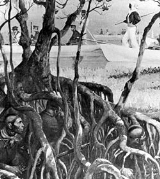
Battle of Wahoo Swamp
Encyclopedia
The Battle of Wahoo Swamp was fought during the Second Seminole War
. An army of militia
, Tennessee
volunteers, Creek mercenaries and United States marines and soldiers led by Florida
Governor
, General
Richard K. Call
, encountered Seminole
forces led by chiefs Osuchee and Yaholooche in Wahoo Swamp.
, a mix-blooded Creek who was the first Native American to graduate from West Point
, tried to determine how deep the stream was, but was shot and killed by the Seminoles. Faced with trying to cross a stream of unknown depth under hostile fire, and with supplies again running short, Call withdrew and led his men to Volusia
.
On December 9 Call was relieved of command and replaced by Maj. Gen. Thomas Jesup
, who took the troops back to Fort Brooke
. The enlistments of the volunteers were up at the end of December and they went home. Call's army gradually pushed the Seminoles back through the swampy marsh. The Seminoles retreated south by nightfall and Call chose not to pursue due to difficult terrain.
Second Seminole War
The Second Seminole War, also known as the Florida War, was a conflict from 1835 to 1842 in Florida between various groups of Native Americans collectively known as Seminoles and the United States, part of a series of conflicts called the Seminole Wars...
. An army of militia
Militia
The term militia is commonly used today to refer to a military force composed of ordinary citizens to provide defense, emergency law enforcement, or paramilitary service, in times of emergency without being paid a regular salary or committed to a fixed term of service. It is a polyseme with...
, Tennessee
Tennessee
Tennessee is a U.S. state located in the Southeastern United States. It has a population of 6,346,105, making it the nation's 17th-largest state by population, and covers , making it the 36th-largest by total land area...
volunteers, Creek mercenaries and United States marines and soldiers led by Florida
Florida
Florida is a state in the southeastern United States, located on the nation's Atlantic and Gulf coasts. It is bordered to the west by the Gulf of Mexico, to the north by Alabama and Georgia and to the east by the Atlantic Ocean. With a population of 18,801,310 as measured by the 2010 census, it...
Governor
Governor
A governor is a governing official, usually the executive of a non-sovereign level of government, ranking under the head of state...
, General
General
A general officer is an officer of high military rank, usually in the army, and in some nations, the air force. The term is widely used by many nations of the world, and when a country uses a different term, there is an equivalent title given....
Richard K. Call
Richard K. Call
Richard Keith Call was the third and fifth territorial governor of Florida.Named after his uncle, a Revolutionary War hero, he was born in Pittsfield, Prince George County, Virginia. In 1813 he left school to take part in the Creek War. He came favorably to the attention of General Andrew Jackson,...
, encountered Seminole
Seminole
The Seminole are a Native American people originally of Florida, who now reside primarily in that state and Oklahoma. The Seminole nation emerged in a process of ethnogenesis out of groups of Native Americans, most significantly Creeks from what is now Georgia and Alabama, who settled in Florida in...
forces led by chiefs Osuchee and Yaholooche in Wahoo Swamp.
Battle
General Call waited to bring his other column across the river, then entered the Wahoo Swamp on November 21. The Seminoles resisted the advance in the Battle of Wahoo Swamp, as their families were close by, but had to retreat across the stream. Major David MoniacDavid Moniac
David Moniac, born December 25th, 1802, died 1836, was a Creek Indian of mixed ancestry, a grand-nephew of Alexander McGillivray.He was the first cadet appointed from Alabama and in 1822 became the first Native American, and first non-white man, to graduate from West Point. He was the only Native...
, a mix-blooded Creek who was the first Native American to graduate from West Point
United States Military Academy
The United States Military Academy at West Point is a four-year coeducational federal service academy located at West Point, New York. The academy sits on scenic high ground overlooking the Hudson River, north of New York City...
, tried to determine how deep the stream was, but was shot and killed by the Seminoles. Faced with trying to cross a stream of unknown depth under hostile fire, and with supplies again running short, Call withdrew and led his men to Volusia
Volusia County, Florida
Volusia County is a county located in the state of Florida. The U.S. Census Bureau 2010 official county's population was 494,593 . Its county seat is DeLand, and its most populous city is currently Deltona....
.
On December 9 Call was relieved of command and replaced by Maj. Gen. Thomas Jesup
Thomas Jesup
Brigadier General Thomas Sidney Jesup, USA was an American military officer known as the "Father of the Modern Quartermaster Corps". He was born in Berkeley County, West Virginia. He began his military career in 1808, and served in the War of 1812, seeing action in the battles of Chippewa and...
, who took the troops back to Fort Brooke
Fort Brooke
Fort Brooke was a historical military post situated on the east bank of the Hillsborough River in present-day Tampa, Florida. The Tampa Convention Center currently stands at the site.-Fort Brooke as a military outpost:...
. The enlistments of the volunteers were up at the end of December and they went home. Call's army gradually pushed the Seminoles back through the swampy marsh. The Seminoles retreated south by nightfall and Call chose not to pursue due to difficult terrain.

